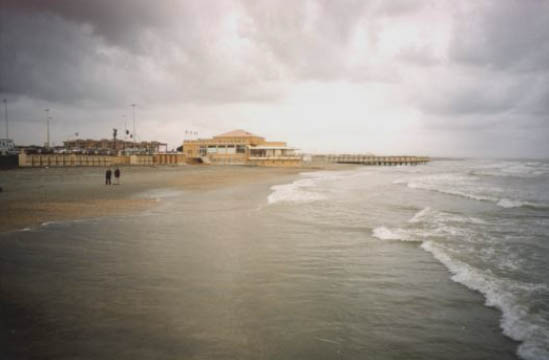| Vecchia Pineta - Italy |
| Complete description
of case study |
PHOTO OF THE SITE
 |
|
CASE STUDY
| Title | Vecchia Pineta |
| National level | Italy |
| Regional level | Regione Lazio, Provincia di Roma |
| Local level | Lido di Ostia |
ABSTRACT
|
Coastal band of the examined site is constituted by a sandy beach of reduced extension. From the land side the beach is bordered by a string of dunes slightly decreasing going towards the shore. The coastal girgle is constituted by a low extension sandy beach, of approx 40 m and weak gradient nearly 1:40. On the sea side the sounding-depth outline shows a system of one or two longitudinal bars. The main wave motion, as far as intensity and frequency, is from S and SW event though there is a significant frequency from W and NW. The sea currents are mainly a wind result, therefore strongly conditioned by the weather variability and, near the cost, by the structure of the bathymetric lines. The wind climate shows a strong frequency predominance from NNE and NE. The greater intensity events seem to be due to the areas between SE and SW also showing a good frequency. The shore erosion forecasts pointed out a global mass of approx. 220.000 m3/year, shared in 100.000 m3/year toward North and 120.000 m3/year South direction, with a net difference of 20.000 m3/year in favour of the south side. During the previous decades this was compensated by Tevere contributions but today, thanks to the works of river regimentation and ground stabilisation, they are decreased helping to trigger erosion phenomena along the entire shoreline. Tourism is the main socio-economic activity of this place. Thus, hinterland and beach, in spite of its remarkable tourist interest, appear barely built with the exception of the restaurant and the cabins over the wharves which do not weightily interfere with the shore-line morpho-dynamic. The Regione Lazio carried out a lot of intervention firstly aimed to hold the line and to a subsequently its advancing. In order to guarantee a long stability, every non-protected action must be combined with a suitable maintenance service. In this contest, it has been carried out the installation of a new system of erosion maintenance and coast resetting, BMS (Beach Management System). This new system has a double aim:
During the previous years a lot of passive protection interventions have been performed, but this actions allowed the erosion phenomena to shift southward. |
BASIC INFORMATION
| Coastal characteristics |
|
| Policy options | Hold the line |
| Socio-economic activities | Tourism |
| Engineering techniques | Historical: submerged breakwaters, nourishments. Present: beach drainage system. |
SOURCE
| Name | Leonardo Damiani |
| Institution | Politecnico di Bari – DIAC |
| Address | Via E. Orabona, 4 – 70125 Bari (Italia) |
| Telephone / fax | +39 080 5963286 /+39 080 5963414 |
| l.damiani@poliba.it |